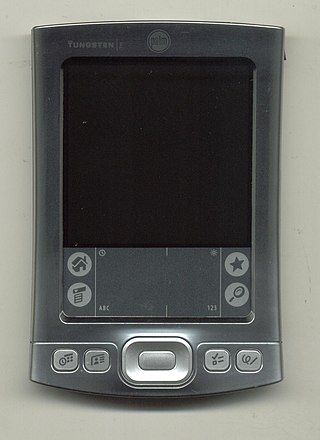
The Memory Stick is a removable flash memory card format, originally launched by Sony in late 1998. In addition to the original Memory Stick, this family includes the Memory Stick PRO, a revision that allows greater maximum storage capacity and faster file transfer speeds; Memory Stick Duo, a small-form-factor version of the Memory Stick ; the even smaller Memory Stick Micro (M2), and the Memory Stick PRO-HG, a high speed variant of the PRO to be used in high-definition video and still cameras.

Secure Digital, officially abbreviated as SD, is a proprietary, non-volatile, flash memory card format the SD Association (SDA) developed for use in portable devices.

The Tungsten series was Palm, Inc.'s line of business-class Palm OS-based PDAs.

The Nokia 9210 Communicator is a third-generation Communicator series mobile phone produced by Nokia, announced on 21 November 2000 and released in June 2001. It greatly improved on the second generation Nokia 9110 Communicator, providing a colour main screen and using an ARM processor. It is one of the few mobile phones able to send and receive fax.

The Sony Reader (ソニー・リーダー) was a line of e-book readers manufactured by Sony. The first model was the PRS-500 released in September 2006 and was related to the earlier Sony Librie, the first commercial E Ink e-reader in 2004 using an electronic paper display developed by E Ink Corporation. The last model was the PRS-T3, after which Sony announced it would no longer release a new consumer e-reader.

Eye-Fi was a company based in Mountain View, California, that produced SD memory cards with Wi-Fi capabilities. Using an Eye-Fi card inside a digital camera, one could wirelessly and automatically upload digital photos to a local computer or a mobile device such as a smartphone or tablet computer. The company ceased business in 2016.

The Nokia E71 is a smartphone introduced on 8 May 2008 from the Eseries range with a QWERTY keyboard targeting business users worldwide. It runs on Symbian OS v9.2, with a Series 60 3rd Edition, second generation Feature Pack 1. The Nokia E71 succeeded the Nokia E61/61i models, building on the base design and form factor but enhancing on the feature set.
Uncompressed video is digital video that either has never been compressed or was generated by decompressing previously compressed digital video. It is commonly used by video cameras, video monitors, video recording devices, and in video processors that perform functions such as image resizing, image rotation, deinterlacing, and text and graphics overlay. It is conveyed over various types of baseband digital video interfaces, such as HDMI, DVI, DisplayPort and SDI. Standards also exist for the carriage of uncompressed video over computer networks.
The Toshiba TG01 is a large touchscreen phone/Mobile Internet Device. It is based on the Windows Mobile operating system and uses Qualcomm Snapdragon chip architecture (QSD8250), rated at 1GHz. Connectivity-wise, it is a quad-band GSM phone with support for 2100 MHz UMTS with HSDPA download speeds of up to 7.2 Mbit/s and HSUPA upload speeds of up to 2 Mbit/s. It is Wi-Fi capable, GPS-enabled with support for A-GPS, and comes with Bluetooth 2.0, microSD expandable memory and a micro USB connector.

MiFi is a brand name to describe a wireless router that acts as a mobile Wi-Fi hotspot device.

Trek 2000 International Limited is a Singaporean technology company that is listed on the Singapore Exchange (SGX:TREK). The company claims to be the inventor of the ThumbDrive, a USB data storage device. The company owns a library of more than 600 patents, with 360 granted patents. It has also developed numerous other products in the same consumer electronics market segments including the Ai-Ball and offers products such as SSDs and Flash Drives. The ThumbDrive trademark is registered by Trek 2000 International in international markets, although the original inventors of the USB flash drive and the related patents are the subjects of multiple disputes.
IEEE 802.11ac-2013 or 802.11ac is a wireless networking standard in the IEEE 802.11 set of protocols, providing high-throughput wireless local area networks (WLANs) on the 5 GHz band. The standard has been retroactively labelled as Wi-Fi 5 by Wi-Fi Alliance.

The Acer Iconia is a range of tablet computers from Acer Inc. of Taiwan.
The E5 is a mobile Wi-Fi device produced by Huawei Technologies, and is part of the company's mobile Wi-Fi series that includes the E5830s, E585, E583c and E586. The E5 series connect to other devices using a wireless interface. The devices are pocket size and allow users to access the Internet through any Wi-Fi device, mobile phone, game console, digital camera, notebook and personal digital assistant (PDA).

Samsung Galaxy Y (GT-S5360) is an Android-based smartphone by Samsung, announced in August 2011. Its main features are 3G connection with speeds up to 7.2 Mbit/s and Wi-Fi.

The Xperia Tablet Z is a touchscreen Android tablet designed and manufactured by Sony and was first announced in Japan in January 2013. It was then announced globally in Barcelona at the Mobile World Congress on February 25, 2013. The tablet is one of the lightest and thinnest 10.1-inch tablet in the world with a weight of 1.09 pounds and is just 0.27 inches thick. The Tablet Z succeeds the Xperia Tablet S with a faster processor, a better front-facing camera, a higher-resolution screen, and Ingress Protection Ratings of IP55 and IP57, for dust-protected, water-jet protected, and waterproof in up to one meter of water for up to thirty minutes. It was released in May 2013. The device retails at $500 for the 16GB version and $600 for the 32gb version.

The second-generation Nexus 7, also commonly referred to as the Nexus 7 (2013), is a mini tablet computer co-developed by Google and Asus that runs the Android operating system. It is the second of three tablets in the Google Nexus tablet series, the Nexus family including both phones and tablets running essentially stock Android which were originally marketed for developer testing but later marketed by Google to consumers as well, all of which were built by various original equipment manufacturer partners. Following the success of the original Nexus 7, this second generation of the device was released on July 26, 2013, four days earlier than the originally scheduled date due to early releases from various retailers. The tablet was the first device to ship with Android 4.3.
Lenovo Vibe P1 is an Android smartphone manufactured by Lenovo. The Vibe P1 was announced on 2 September 2015 at IFA 2015. It was launched in October 2015 for US$249. It was available in Silver, Platinum and Graphite Grey and Gold colour variants.

The PinePhone is a smartphone developed by Hong Kong-based computer manufacturer Pine64, intended to allow the user to have full control over the device. Measures to ensure this are: running mainline Linux-based mobile operating systems, assembling the phone with screws, and simplifying the disassembly for repairs and upgrades. LTE, GPS, Wi-Fi, Bluetooth and both cameras can be physically switched off. The PinePhone ships with the Manjaro Linux operating system using the Plasma Mobile graphic interface, although other distributions can be installed by users.
The Samsung Galaxy A20s is an entry level smartphone developed by Samsung Electronics announced on September 23, 2019, and released to the general public on October 5, 2019. It was discontinued on January 16, 2023.












